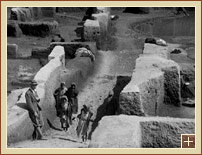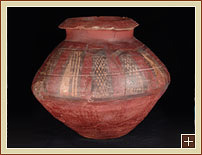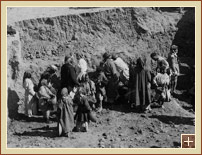The Kish Collection: Introduction
 [/kish/fieldmus/images/IN3-large.jpg]
[/kish/fieldmus/images/IN3-large.jpg]
This photograph shows the massive depth and breadth of the excavations in the Y sounding on Ingharra. The field director, Charles Watlin, and workmen are visible in the foreground.
Kish East, Ingharra, Y Sounding. 1928-1929 Season. Field Museum Negative 67093.
The ancient city of Kish was occupied from at least as early as 3200 B.C. through the 7th century A.D. Located on the floodplain of the Euphrates River eighty kilometers south of modern Baghdad, the city held an extraordinary position during the formative periods of Mesopotamian history. At that time, it seems to have been the only important city in the northern part of the alluvium, while there were several major centers in the south. The ancient Mesopotamians regarded Kish as the first city to which "kingship descended from heaven" after the great flood that had destroyed the world. During the third millennium B.C., rule over Kish implied dominance over the entire northern part of the plain, and the title "King of Kish" bestowed prestige analogous to that of the medieval "Holy Roman Emperor."
 [/kish/fieldmus/images/IN2-large.jpg]
[/kish/fieldmus/images/IN2-large.jpg]
Vessels decorated with shades of red, dark brown, and white are characteristic of the Jamdat Nasr Period, which takes its name from one of the sites excavated by the Kish Expedition. It was there that polychrome pottery was first found in large quantities.
Jamdat Nasr, Baked clay. Jamdat Nasr Period. Field Museum 158312
From 1923 through 1933, joint archaeological expeditions of The Field Museum of Natural History and Oxford University explored many of the twenty-four-square-kilometer site's forty mounds, uncovering significant evidence of Kish's extremely early urbanization and its prominence as a dominant regional polity. However, no final site report of the work of those seasons was ever published.
 [/kish/fieldmus/images/IN1-large.jpg]
[/kish/fieldmus/images/IN1-large.jpg]This photograph shows the large numbers of workmen who were employed by the expedition and the consequent intensity of the excavations and the quantities of earth moved.
Kish East, Mound A, Palace, Courtyard 6, 1923-25 Seasons. Field Museum Negative 52793
The lack of a final site report for Kish stands as a significant lacuna in the archaeological record of Mesopotamia, effectively precluding an understanding of the true historical significance of this crucial Mesopotamian city. The Field Museum, along with the Ashmolean Museum and the Iraq Museum, hope to make such a final publication of the Kish excavations a reality. Roger Moorey, in the preface to his 1978 work Kish Excavations 1923-1933, undertaken to produce a catalogue of the Ashmolean's Kish holdings, concisely encapsulates the necessity of this endeavor:
"In undertaking this project, nearly fifty years after the excavations were started, I have been very conscious that the original work was inspired by aims no longer recognized as viable and executed by methods which were largely inadequate...It would be to confound the evil if the results of this excavation were for these reasons ignored and the finds, with what is left of the records, allowed to suffer further neglect. It would be particularly so at a time when fresh excavations at Kish on this scale are unlikely, though modern development there is radically modifying the site. Ideally all three collections should be fully published as a single unit..." (pp. viii, xxi)
This website details the history, progress, and future prospects of the Kish Project, a federally funded effort to virtually reconcile and publish, in both print and digital formats, the expansive—and divided—collection of ancient material culture from the Mesopotamian city of Kish.
The Field Museum
The Field Museum, 'The Kish Collection: Introduction', The Field Museum's Kish Database Project, 2004-09, The Field Museum, 2025 [http://oracc.org/kish/fieldmus/Introduction/]